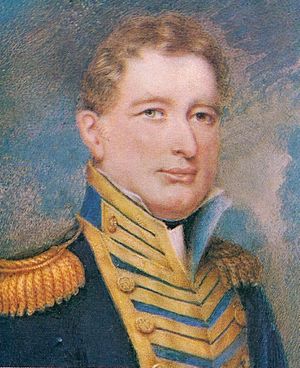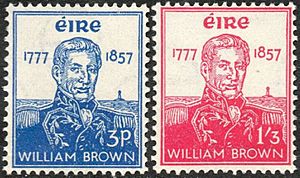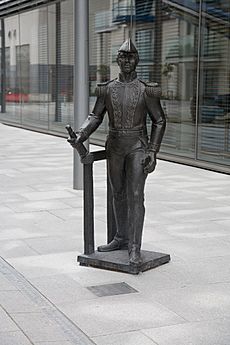William Brown (admiral) facts for kids
Quick facts for kids
William Brown
|
|
|---|---|
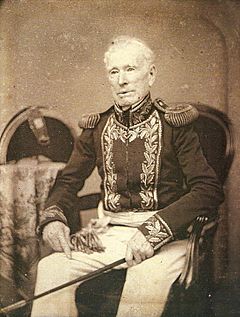
1850s daguerreotype of Brown
|
|
| Nickname(s) | Guillermo Brown |
| Born | 22 June 1777 Foxford, County Mayo, Ireland |
| Died | 3 March 1857 (aged 79) Buenos Aires, Argentina |
| Buried |
La Recoleta cemetery
|
| Allegiance | |
| Service/ |
|
| Rank | Admiral |
| Battles/wars | Napoleonic Wars Argentine War of Independence Cisplatine War Argentine Civil Wars |
William Brown (also known as Guillermo Brown or Almirante Brown) was an important Irish-born Argentine admiral. He was born on June 22, 1777, and passed away on March 3, 1857. Brown became a hero in Argentina because of his victories in the Argentine War of Independence, the Cisplatine War, and the Anglo-French blockade of the Río de la Plata. He is known as the "father of the Argentine Navy" because he created and led the country's first naval forces.
Contents
Early Life of William Brown
William Brown was born in Foxford, County Mayo, Ireland, in 1777. When he was 16, he moved to America with his father in 1793. Sadly, soon after they arrived, both his father and the friend who invited them died from yellow fever.
One day, while walking by the Delaware River, William met a ship captain. The captain offered him a job as a cabin boy, which is a young helper on a ship. William took the job, and this was the start of his amazing naval career. He worked very hard and eventually became the captain of a merchant vessel.
Not much is known about Brown's very early life. Some people think he might have been born out of wedlock and used his mother's last name.
Adventures in the Napoleonic Wars
After ten years at sea, William Brown became a skilled sailor and a captain. During the Napoleonic Wars, he was forced to join a Royal Navy warship. This practice of forcing sailors into service was called "impressment."
Brown managed to escape from the ship he was on. He was later captured by the French and imprisoned in different places, including Verdun. In 1809, he escaped again with a British officer and made it to German territory.
After returning to England, he decided to leave his life at sea for a while. He married Elizabeth Chitty in July 1809. Later that year, he moved to the Río de la Plata region and became a merchant in Montevideo, Uruguay.
Moving to Argentina
William Brown became a part-owner of a ship called Eliza. He used it to trade goods between Montevideo and Buenos Aires. When the Eliza got stuck, Brown took his cargo inland. He sold it for a good profit and then traveled across the Andes mountains to Chile.
He earned enough money to buy his own ship, a schooner named Industria (which means "Industry"). With this ship, he started the first regular shipping service between Uruguay and Argentina. However, the Spanish colonial government saw this new service as a threat to their own trade.
Fighting for Argentina's Freedom
The Spanish ships destroyed Brown's schooner. They also tried to stop Argentina from defending its coasts. Because of this, Argentina decided to build its own navy to protect its trade. William Brown was chosen to lead this new fleet. He was made a lieutenant-colonel and Commander-in-Chief of the Argentine navy.
Brown's friend, Benjamin Franklin Seavers, was his second-in-command. Seavers led the first attack against the Spanish navy. This attack helped clear the way for the Argentine fleet. Sadly, Seavers was the first to die in the battle. His death made Brown even more determined to fight the Spanish.
On March 10, 1814, Brown's ship, the Hercules, and other Argentine ships faced a strong Spanish fleet. The battle was fierce, and the Hercules got stuck. Many sailors were killed or wounded. The Hercules was hit many times by cannons, but it was repaired and nicknamed 'the Black Frigate'. On March 17, Brown attacked Martín García island.
Martín García island was a very important place, known as "the Gibraltar of the River Plate." It controlled access to the Paraná and Uruguay rivers. Brown's first attempt to take the island failed, and his ship was badly damaged. But on March 14, after a tough fight, he successfully captured Martín García.
Brown then chased the Spanish ships to Montevideo. He blocked their port, causing them to run low on food. On May 14, Brown tricked the Spanish fleet into leaving the safety of their forts. Two days later, a big battle happened. Brown's leg was badly injured by a cannonball, but he kept giving orders from the deck of his ship. The Spanish ships panicked, and three of them were captured. Because of this victory, the Río de la Plata was freed from Spanish control, and Montevideo fell to the Argentines.
Even after Argentina won, Brown continued to fight. He chased Spanish ships along the coasts of America and across the Pacific Ocean. Later, he returned to England and then to Argentina. He was given his ship, the Hercules, as a gift. William Brown then spent 14 peaceful years farming with his family.
War with Brazil
William Brown remained ready for action. The region of Uruguay had been a source of conflict for a long time. Now, it caused war between Argentina and Brazil. On December 14, 1825, war officially began.
Argentina did not have an experienced admiral or a strong navy at first. Brown had often suggested building a better fleet, but he was not listened to. Finally, his chance came. He was asked to come out of retirement to protect the port of Buenos Aires. Brown accepted the mission. He worked hard to build and equip a new fleet.
Brazil started by blocking Argentina's ports. Brown took command of Argentina's new naval squadron. Before a battle, he famously said, "Comrades: confidence in victory, discipline, and three hails to the motherland!" and "Open fire, the people are watching us!" He attacked the Brazilian coast and damaged their ships. In the Battle of Juncal on February 24, 1827, he destroyed the entire Brazilian squadron.
On June 11, 1826, the Battle of Los Pozos took place near Buenos Aires. Argentina had only eleven ships against Brazil's thirty-one. Brown later fought in the Battle of Monte Santiago. Peace eventually followed, and Brown helped negotiate the 1828 Treaty of Montevideo on October 4, 1827.
Conflict in Uruguay
Disagreements within Uruguay led Argentine leader Juan Manuel de Rosas to support his friend, Manuel Oribe, in a civil war. William Brown returned to active service. He defeated his former officer, John Coe, in three battles near Montevideo.
On August 15, 1842, Brown fought a battle on the Paraná River against a Uruguayan fleet. This fleet was led by Giuseppe Garibaldi, who would later become a hero in Italy. Brown won the battle and chased the Uruguayans up the river. His marines then fought them on land.
During this time, some of Brown's men acted dishonorably towards a prisoner. Brown was very angry about this. He believed in honor in battle and severely punished his men for their actions. He even used his influence to get Garibaldi released from prison, showing his respect for a brave opponent. Brown often said, "Even if to the devil the word is given, then it must be kept," meaning promises must be kept. Garibaldi later named one of his grandchildren "William" after Brown.
The Argentine forces took control of most of Uruguay. However, they could not capture Montevideo, which was under siege for nine years. In 1845, the United Kingdom and France joined the conflict on the other side.
Later Years and Legacy
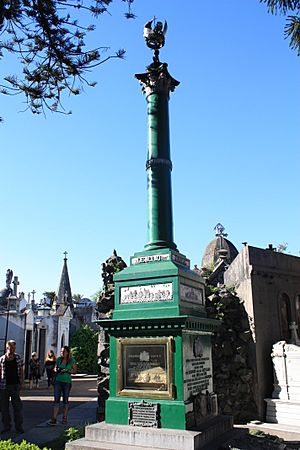
In 1847, Admiral Brown visited his hometown of Foxford in Ireland with his daughter. After the Rosas government fell, many naval officers lost their jobs, but Brown remained honored for his long service.
He retired to his home, Casa Amarilla, in Barracas. His old opponent from the Brazilian war, John Pascoe Grenfell, visited him. Grenfell said that the country was not grateful enough to its good servants. Brown replied that he was happy to have served the country of his children. He felt that honors and wealth were not important when a small piece of earth was enough for his final rest.
William Brown passed away on March 3, 1857. He was buried with full military honors. The Argentine government announced that Brown's life of service showed the naval glory of Argentina. General Bartolomé Mitre famously said, "Brown in his lifetime, standing on the quarterdeck of his ship, was worth a fleet to us." His grave is in the Recoleta Cemetery in Buenos Aires.
Remembering Admiral Brown
Both Ireland and Argentina have honored William Brown. Stamps showing him were issued in Ireland in 1957 and 2003. Argentina has issued many stamps in his honor since 1891.
Since the mid-1980s, Admirals of the Argentine Navy wear a replica of Brown's sword. One replica is in the National Maritime Museum of Ireland. The original sword is in the National Historical Museum of Argentina.
Statues and memorials celebrating Brown's battles can be found in Buenos Aires and in his birthplace, Foxford, Ireland. A museum dedicated to him is open in Foxford. In 2006, an Irish naval ship, LÉ Eithne, traveled to Buenos Aires to celebrate 150 years since Brown's death. It also brought a statue of Brown to be displayed in Dublin.
Bertie Ahern, the Irish Prime Minister, spoke at the unveiling of a new statue of Brown in Dublin in 2006. He mentioned how important William Brown is in Argentine history and how strong the links are between Ireland and Argentina.
The Brownian National Institute (Instituto Nacional Browniano) was created in 1948. It is located in Casa Amarilla, a replica of Brown's house in the La Boca neighborhood of Buenos Aires. The institute studies Argentina's maritime history and Brown's life.
Many Argentine warships and places have been named after him, including:
- The Almirante Brown class class of destroyers.
- ARA Almirante Brown (C-1), a cruiser used during World War II.
- ARA Almirante Brown (D-10), a destroyer currently in service.
- The Almirante Brown Antarctic Base in Antarctica.
- A tribute song called "Admiral William Brown" by the Wolfe Tones in 1982.
- The Almirante Brown department in Chaco Province.
- The Almirante Brown Partido in Buenos Aires Province.
- The Admiral William Brown National College, a high school in Adrogué.
- Four different football clubs: Club Atlético Almirante Brown (Arrecifes), Club Almirante Brown (Isidro Casanova), Brown Athletic Club (Adrogué), and Guillermo Brown (Puerto Madryn).
Since 2012, the winner of rugby matches between Argentina and Ireland receives The Admiral Brown Cup.
See also
 In Spanish: Guillermo Brown para niños
In Spanish: Guillermo Brown para niños
- Irish military diaspora
- list of people on stamps of Ireland


